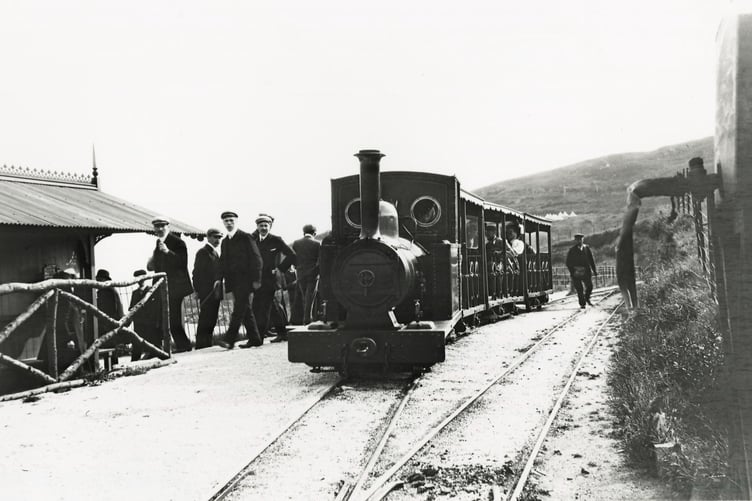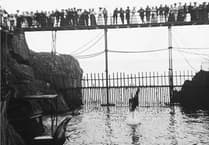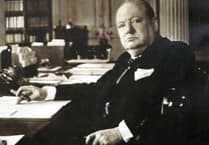Thanks for the good feedback on last week’s piece on Groudle Glen.
Again, sincere thanks to Suzanne Cubbon and her most informative book ‘Manx Glens – A Stroll Through History’, published in 2004 and still available in a number of outlets, for much of the information.
Also, a very useful reference from which I have obtained detailed information is Isleofman.com, so thanks to that source as well.
I started the story about Richard Maltby Broadbent and the success of ‘the world’s smallest railway’ last week, but sadly it was not all good news.
Indeed, in the first season there was a terrible accident. On the morning of August 28, 1896, the ‘Sea Lion’ was approaching the pool terminus on her second trip.
The coaches were full of excited tourists, but tragedy struck when the loco failed to stop as she reached the newly erected ‘stop block’ at the end of the line.
‘Sea Lion’ and all three carriages were derailed, and a total of 16 people were injured. The injured passengers were transported back to the hotel, where they were met by doctors who had been sent for from Douglas.
Despite this occurrence, the overall success of the railway led to a second engine being purchased, and it was named the ‘Polar Bear’.
However, after the First World War, the price of coal rose dramatically and the two steam engines were replaced with two new battery-powered trams.
All went well for the next six years, until the two trams literally wore themselves out with constant use. Coal prices had now stabilised, so the two old faithful steam engines were given a complete overhaul and brought back into service.
The actual polar bears were retired during the First World War, and during the Second the pool was closed and the sea lions released.
Unfortunately, when the railway reopened again in 1946, the Groudle company suffered badly with vandalism.
A landslide on the headland made it impossible for the trains to reach the pool, and with the sea lions gone, it was decided to close the line.
In 1961, the Groudle line was taken over by Groudle Ltd, with directors C.M. Watterson, W.L. Callister and J.R. Keig.
The company was plagued with problems, and trains only operated for two years before closing. As they lay dormant, the locomotives, coaches, sheds and tramlines were seriously vandalised over the years — to such an extent that one of the coaches ended up in the sea.
Onchan Village Commissioners, a forward-thinking authority, took over the glen in 1967 when they paid Groudle Ltd £3,250. This excluded the hotel.
They later sold the lower half of the glen to Harbour and Glen Investments, who built the holiday village and also set up Tynwald Mills.
The remainder of the glen was taken over by the government in 1975 on a 99-year lease with a yearly rent of £5.
The Onchan branch of the Rotary Club, in conjunction with the Department of Transport and DAFF, constructed in the summer of 2001 a new path underneath the Whitebridge Road to connect the two glens of Groudle and Molly Quirk’s.
The bulk of the work was undertaken by the members themselves, who gave up their spare time to construct this useful connection, making access from one to the other much safer.
This part of Groudle Glen, like others around the island, suffered much damage during recent storms, and the last time I visited it was closed in places for public safety as DEFA undertook repair work.
Back once more to the Groudle Glen Railway, now owned and operated by a small group of enthusiastic volunteers. But how did that come about?
In 1982, the IoM Steam Railway Supporters’ Association launched a plan to restore the line, and work began clearing 20 years’ worth of undergrowth covering the trackbed.
Amazingly, in 1983 a short section from the old lime kiln to the headland opened, running Santa Trains.
Further sections of the line were painstakingly relaid, eventually reaching the glen terminus at Lhen Coan.
A station was created at the headland with run-round facilities. The complete railway was officially reopened on 23rd May 1986 by Carolyn Rawson as part of the Manx Heritage Year — which, in my opinion, alongside Millennium Year in 1979 and Year of Sport in 1985, was an outstanding success.
In September 1987, the original steam loco Sea Lion returned to the railway after a full restoration. By 1991, it was decided to relay the final section of the line from the headland loop to the former terminus at Sea Lion Rocks.
The extension, recreating the line to its original three-quarter mile length, was opened on July 23, 1992.
In 1993, the lovely Swiss-style station canopy at Lhen Coan — a feature of so many postcards of the glen — opened as part of the fabulous ‘Year of Railways’ celebration, which was masterminded by the late Alan Corlett under the then-director Robert Smith.
In 1993, ‘Polar Bear’ also returned to the glen for a visit — a time of great change for the line, with many improvements being introduced by the volunteers.
Visiting locos featured in 1995 and also in 1998, as part of the ‘Steam 125’ events marking the anniversary of the steam railway.
Planning permission was granted in 1999 for the volunteers to erect a replacement station building at Sea Lion Rocks, and by the next summer, work was well in hand.
The building opened in 2001, and in 2003 the interior of the station was completed, which proved to be a major draw to the railway and has become a focal point for so many successful events since.
The addition of a replica battery electric loco in 2003 completed the line’s historical line-up.
A return visit from ‘Polar Bear’ for her own centenary in 2005 was very welcome.
In 2007, a new purpose-built locomotive shed was erected on the site of the original — but to a larger scale — and a mess hut was installed, which transformed the station at Lhen Coan in keeping with the original site.
In September 2007, a plaque was unveiled to mark the 25th anniversary of the restoration, and the occasion also marked the official opening by Anne Craine MHK of the railway’s new purpose-built loco shed. Plans were well in hand to rebuild the souvenir shop at Lhen Coan, and this was fully opened at Easter 2010.
In the same year, an appeal was launched to raise the £60k required to extend the Sea Lion Rocks Tea Rooms to provide toilet facilities, a power supply, and an improved patio area.
This was completed in time for the Easter 2012 services and was opened by Allan Bell, then Chief Minister, to mark the 30th anniversary of the railway’s restoration.
During 2012, planning permission was granted to enlarge the platform area and replace a time-expired utility building at Lhen Coan. Construction work, funded by the Manx Lottery Trust and Tower Insurance, required the railway to transport 140 tons of rock to the site for foundations and infill.
The volunteers and supporters at Groudle Glen Railway have not stopped since 1982 and have delivered a project the island should be proud of — one which so many enjoy at Easter, Christmas, and during the summer. Well done!



.jpeg?width=209&height=140&crop=209:145,smart&quality=75)
